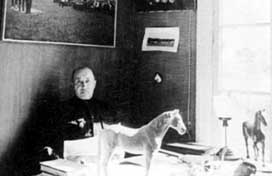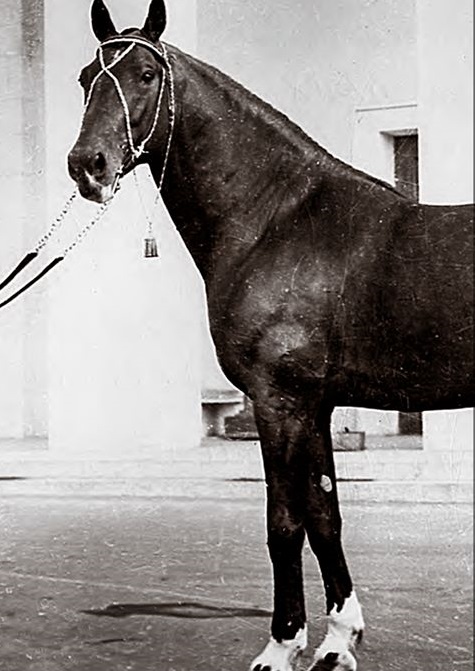HISTORY
 The history of Moscow Stud Farm No. 1 reflects the most important events in the life of the industry and of the entire country, as well.
The history of Moscow Stud Farm No. 1 reflects the most important events in the life of the industry and of the entire country, as well.
Initially, the Moscow Stud Farm was established to breed a domestic Orlov Trotter, and its location was chosen for its proximity to research centres for horse breeding.
The Orlov Trotter is the crown jewel of Russian horse breeding, created by Count Aleksey Orlov in the late 18th century. They are well adapted to Russian climate and have always been easy to keep. Their stunning beauty is complemented by excellent performance and pedigree. The Orlov Trotter excels as a coach horse, riding horse and sport horse.
Russia’s horse breeding industry fell into ruins after World War I and the ensuing Civil War. The military requisitioned the best horses, and inferior nutrition and care combined with a heavy workload had an adverse effect on the quality of the stock.
During the Russian Revolution of 1917, peasants took stud horses from private breeding farms, and their pedigrees were lost.
The Decree of the Council of People's Commissars On Pedigreed Livestock Breeding dated 23 July 1918 and signed by Vladimir Lenin proclaimed that all pedigreed livestock belonging to “non-working” families was nationalised with no compensation to owners. This document was a foundation for all efforts to organise the national animal husbandry and horse breeding. Since that time, the country started establishing stud farms controlled by local agricultural authorities and the People's Commissariat for Agriculture. By that point, most of the surviving pedigreed horses were racehorses kept at hippodromes, and the state-owned local stud farms received this lightweight livestock for breeding.
By the time of the establishment of the Moscow Stud Farm, specialists doubted that the Orlov Trotter breed could be preserved in its original form because there were barely 200 pureblood, high-quality Orlov Trotters left.
Under the order of the People's Commissariat for Agriculture dated 24 October 1924, the Moscow Stud Farm was established to revive and improve the Orlov Trotter breed and serve as a base for the Horse Breeding Research Institute.
Professors V. Witt, S. Vaganov-Movo and N. Tijef established and organised the breeding operations at the Stud Farm. V. Elagin was the first head of the horse care department and V. Dobrynin was the first head of breeding. The Stud Farm’s research team featured Russia’s top equine specialists: Moscow Zoological Technology Institute professors P. Kuleshov and i. Popov, Timiryazev Agricultural Academy professors A. Zhebrak, V. Shchekin, and V. Dobrynin, and Moscow Land Department (MOZO) representatives S. Zaitsev and S. Lesly.
The Orlov Trotter type that would become typical of Moscow Stud Farm took shape in the late 1970s. These Orlov Trotters are of average height, with distinctive pure-breed features, elegant forms, lean bodies, and early maturity. The best sires — Kvadrat 2:08.1 (Proliv — Keramika), Prival 2:08.8 (Veter — Piramida) and Pion 2:00.1 (Otklik — Pridannitsa) contributed greatly to the creation of this Orlov Trotter type.

Legend of Kvadrat
All of the hard work by the Stud Farm’s researchers and employees paid off with the birth of the famous stallions Kvadrat and Pion – both masterpieces of Orlov Trotter breed. From that point on, the greatest achievements of the entire industry were associated with these two sires and their proper use.
 Jockey V. Bazanov trained Kvadrat at the Moscow Stud Farm, but the stallion owed his impressive and flawless career exclusively to the master rider Alexander Roschin at the Moscow Hippodrome. During his brilliant career, Kvadrat competed against his coeval Orlov Trotters and Russian Trotters and managed to win all the traditional prizes: two winter 3YO, two summer 3YO, two winter 4YO, and two summer 4YO.
Jockey V. Bazanov trained Kvadrat at the Moscow Stud Farm, but the stallion owed his impressive and flawless career exclusively to the master rider Alexander Roschin at the Moscow Hippodrome. During his brilliant career, Kvadrat competed against his coeval Orlov Trotters and Russian Trotters and managed to win all the traditional prizes: two winter 3YO, two summer 3YO, two winter 4YO, and two summer 4YO.
Kvadrat sired many horses, both naturally and through the artificial insemination. In 1951–1952, he was the Moscow Stud Farm’s first sire whose material was widely used at other stud farms around the country.
Kvadrat’s offspring embodied the best qualities of the Orlov Trotter and have been always in demand at international auctions. Stud farms from 14 countries have purchased many of them.
The Russian Troika
Moscow Stud Farm No. 1 entered a new phase with the establishment of its Russian Troika department and the triumphs of the horses trained there. By the mid-1950s, rapidly developing international economic and cultural ties propelled the Soviet Union to find a visually expressive way of demonstrating its achievements in horse breeding and equestrian training, and Russian Troika races were incredibly dramatic.

Through years of effort and enthusiasm, the Stud Farm’s specialists brought the Russian Troika back into Russia’s cultural landscape as a vivid element of folk festivities. Russian Troika competitions have once again become a national sport.
Since the 18th century, the Troika has had such an important place in Russian history and culture that even now it is considered a symbol of our country. Several generations of writers, poets and artists were inspired by the image of the Troika racing across a snow-swept field. By the late 19th century, however, they were replaced by iron steam “horses”, and the cosy post stations were replaced by noisy railway stations.
The Russian Troika originated during the reign of Peter the Great, whose reforms redesigned the country’s transportation system. At that time, a carriage driven by two or three horses harnessed in a row was considered the most convenient form of transportation. When the carriage was driven by a pair called a “detached pair”, one horse acted as lead horse and the other was the outrunner.
A horse team harnessed this way was fast. There were two types of team harness: working and riding (semi-coach). The Russian Troika evolved from the riding harness by attaching the second outrunner on the other side of the leader. The Troika’s endurance, carrying capacity and good manoeuvrability were appreciated almost immediately, although officially this type of harness was legalised only in 1770 when the postal service was reorganised.
The Russian Troika looks so expressive because all three horses are facing in different directions and using different gaits. The horses are selected based on their strength and stamina. The robust lead horse is taught to trot while the lighter outrunners gallop beautifully, bending their heads to the side and down. The left one gallops on the right lead and the right outrunner gallops on the left lead. This style requires cooperation and self-control on the part of the horses, who have to choose the leading leg instinctively and independently in order to keep the harness stable. When the front leg is extended to the rear, it must balance out the head, which is turned in the other direction; everything is strictly subordinated to a single rhythm of movement so that the carriage moves smoothly and evenly. Each horse’s temperament, character and physical strength must be considered when they are assigned to their places in the harness.
Alexander Roshchin was an equestrian who had mastered the arcane secrets of the art of the troika, and the executives of the Moscow Hippodrome asked him to create its first troika for show. Roshchin was descended from a renowned family of equestrians in Ryazan region. He was an established equestrian specialist and an excellent rider. His knowledge and experience were the key to the rebirth of the troika.
On 24 March 1957, the first show race of Russian Troikas was held over a distance of 2,000 metres.
Thanks to the enthusiasm and efforts of the specialists of Moscow Stud Farm No. 1, Russian Troika competitions were restored in 2000 after a short interruption. Year after year, the characteristics and team skills of the horses and the mastery of the drivers have progressed.
At the Turn of the Century
At the end of the 20th century, Moscow Stud Farm No. 1 faced many challenges. In the late 1980s, economic reforms destroyed the established farming principles and had a tragic effect on the animal husbandry, leading to its collapse in the 1990s.
In the early 2000s, Acron Group, a leading fertiliser producer in Russia and globally, became a major shareholder of Moscow Stud Farm No. 1. With Acron Group’s help, Moscow Stud Farm No. 1 repaired the equestrian department and completed the refurbishment and reconstruction of its paddocks and a large-scale overhaul of the riding hall complex with modern stalls. The riding hall field was covered, the roof and stalls were repaired, the training fields and paddocks were upgraded, and the entire facility was equipped with effective ventilation and air-conditioning systems. In the autumn of 2002, the reconstruction of the arena and the interior was completed.
On 20 October 2002, Moscow Stud farm No. 1 opened a youth equestrian school where children from the Odintsovsky District can train free of charge. This was a remarkable event in the cultural and sports life of the country and marked a new millennium.
Russian Federation President Vladimir Putin opened the official ceremony. In his address, he stated that “horse breeding and equestrian sports have always been in the Russian tradition, and today's opening of this school is a revival of what the country used to have”. The president also emphasised that “Russia has always set the bar high” in horse breeding and equestrian sports. He expressed confidence that “we will not only reach our former heights, but will continue to rise higher”. At the end of the opening ceremony, the Russian president presented the school with a purebred Arabian stallion named Albatros.
Since 2002, Moscow Stud farm No. 1 has held an annual equestrian competition in late October to mark the anniversary of the opening of the youth equestrian school.